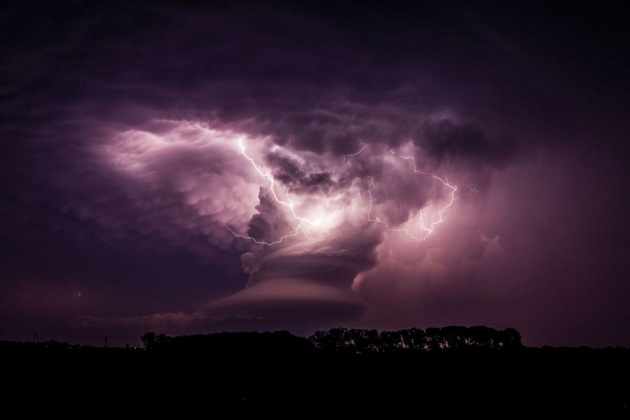
THE STAR OF thunderstorm theatrics, booming and flashing, is lightning: ever-gorgeous and destructive. Flashing four million times a day around the world, lightning can transform landscapes—starting wildfires in remote forested areas. It can also bring cities to their knees, as when a lightning strike to a power station in Brazil caused a blackout in Sao Paulo and Rio de Janiero that affected 97 million people and shut down both cities. And depending on where you choose to stand during a thunderstorm, lightning can kill you.
Both a powerful and relatively regular phenomenon, lightning’s antics have inspired fear and devotion throughout history, as Derek M. Elsom describes in a new book, Lightning: Nature and Culture. Ancient Mesopotamians, Romans, Hindus, and Chinese cultures spun mythologies around passionate, angry storm gods. In depictions, deities hold forks of lightning, ready to smite those silly enough to tempt them. And lightning still has a fascinating cultural allure. Films like Frankenstein, Scars of Dracula, and Snow White and the Seven Dwarves star lightning to mark the births of monsters and deaths of bad guys. But what’s the science behind the mythology?
The question of why lightning happens remains unanswered, but scientists have figured out the how. The showy performances are a collaborative effort, born from the electrical tension between earth and the atmosphere. You live in one massive capacitor composed of the positively charged outer atmosphere and negatively charged earth. On a fine day, you don’t feel the electrical charge because the atmosphere around you doesn’t bother with conducting the electricity. But when a thunderstorm starts to roll in, everything goes topsy turvy.
Warm air starts rising up into cooler climes and condenses to build dark, heavy thunderclouds. During cloud formation, electrical charges are going crazy. If you looked inside the thundercloud, you would see positively charged particles bunching at the top and a heap of negatively charged particles piled at the bottom. So powerful is the cloud’s negative charge that it repels Earth’s natural negativity deep into the ground, making room for a field of positive charge that shadows the thunderstorm as long as it lasts.
And finally, once the opposite charges reach a boiling point, the stage is set for lightning’s grand entrance. The built-up electrical reserve slices through the normally resistant air. A negative channel, called a leader, zips down toward the ground while a positive channel, called a streamer, rushes upwards to meet it. When they crash together, the rapid electrical discharge burns up and down through both channels. You see those exchanges as lightning, in its many forms. Gaze in wonder at the photos in the gallery and be grateful that you’re not outside in the middle of a thunderstorm.



